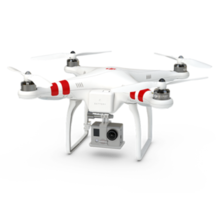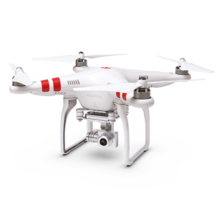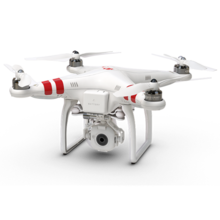Chinese biggest drone maker invented their first generation flying camera in 2013, now is on generation 4.
Flying time 23 - 28 mins
Speed: 54km/h - 72km/h
The Phantom 1, originally known as Phantom, was released in January, 2013. It was commonly equipped with a GoProcamera for amateur film making or photography. It was the first ready-to-fly drone that used GPS[citation needed]. Its battery life was less than 10 minutes.
The Phantom 1
Phantom 2
The Phantom 2
The Phantom 2 Vision
The Phantom 2 was released in December, 2013. Upgrades include auto-return, increased flight speed, increased flight time and controllable range, increased battery capacity, smartphones, tablets and even some smart glasses compatibility, WI-FI module and is available in different performances. Its configuration allows users to remotely tilt the camera and adjust its orientation on two axes for a better level shot.[2]
Phantom 2 Vision
Released in October, 2013,[3] it features a 4GB micro SD card, a built-in anti-vibration mount, advanced WI-Fi module, a GPS-enabled position holding, return-to-home capability, an improved flight control system, self-tightening propellers and flight time. It is compatible with a ground station and iOS or Android devices.
Phantom 2 Vision+
The Phantom 2 Vision+
The Phantom 2 Vision+, released in July, 2014, adds a three-axis electronic stabilizer which keeps the shot steady regardless of changes in pitch, roll or yaw. It has a new remote control system, and has an increased controllable range.[4] It received a no-fly zonefirmware update, which warns the user when flying in areas where UAVs are not allowed to fly (ex. airports).
Phantom FC40
The Phantom FC40
The Phantom FC40, released in January, 2014, is an intermediate model between the Phantom 1 and the Phantom 2. Like the Phantom 2 Vision and the Phantom 2 Vision+, it is equipped with an iOS/Android app control, WI-FI and GPS modules. Using a 2.4G Wi-Fi connection, it helps its pilot follow in real time via aerial pictures on a mobile device. The camera angle is manually set before the flight and tilted by remote control.
Phantom 3
The Phantom 3, released in April 2015,[5] adds built in lightbridge downlink, that gives the controller a maximum range of 2,000 meters (1.25 miles), and the visual positioning system, that allows the Phantom 3 to better maintain its position at lower altitudes and even indoors where GPS is weak or unavailable.
The controller features a plastic front plate and lacks a HDMI out.
There are three models of the Phantom 3:
- Professional: features 4K video recording and a 100 watt charger.
- Advanced: features 2.7K video recording and a 57W charger.
- Standard: release in August 2015, it is cheaper and features 2.7k video recording.
Applications
Play media
Example aerial video of Snowdoniafilmed with a DJI Phantom 2 Vision+ quadcopter
Although the commercial use of drones is still in a legal gray area, several segments of industry are open to its usage and already seeing many benefits. Among their many applications, the most well known are drone journalism,[6] hurricane hunting, 3-D mapping of landscape, nature protection,[7] farming, and search and rescue.[8][9][10] Drones are being used in entertainment[11] as well as in business. The Fox Broadcasting Company used Phantom 2 Vision+ quadcopters to promote the show 24 during the San Diego Comic-Con International 2014.[12]
https://en.m.wikipedia.org/wiki/Phantom_(UAV)
- Forums
- ASX - By Stock
- IOT
- Nixie wearable drone, another competitor
Nixie wearable drone, another competitor, page-17
-
- There are more pages in this discussion • 187 more messages in this thread...
You’re viewing a single post only. To view the entire thread just sign in or Join Now (FREE)














